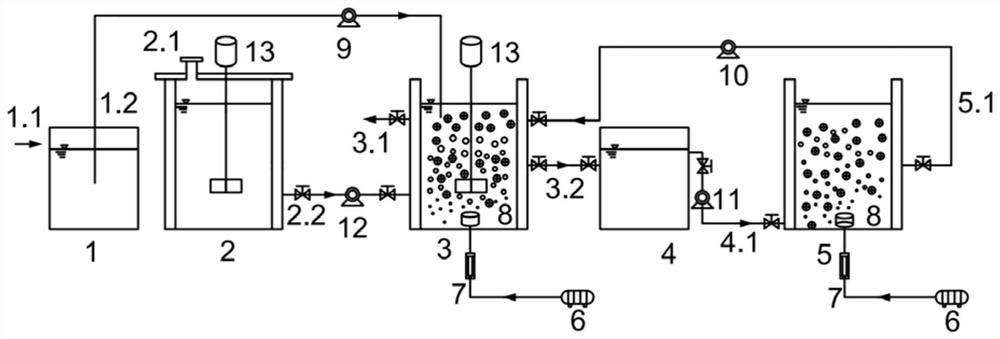Process for treating municipal sewage through excess sludge fermentation carbon source enhanced denitrifying phosphorus removal-partial short-cut denitrification-anaerobic ammonia oxidation
A technology of denitrification and phosphorus removal and short-range denitrification, which is applied in the field of energy-saving and consumption-reducing sewage treatment technology, can solve the problems of increased operating costs, difficulty in the treatment of excess sludge, and the inability to achieve the best denitrification and phosphorus removal effects at the same time. The effect of wide application value and simple process flow
- Summary
- Abstract
- Description
- Claims
- Application Information
AI Technical Summary
Problems solved by technology
Method used
Image
Examples
Embodiment Construction
[0028] The present invention will be described in further detail in conjunction with the accompanying drawings and embodiments.
[0029] Such as figure 1 As shown, a new process for treating urban sewage with a dual-sludge system of denitrification and phosphorus removal coupled with partial short-range denitrification and anaerobic ammonium oxidation using excess sludge fermentation carbon source in urban sewage treatment plants includes the following parts: Raw water tank (1) , SBR1 reactor (2), SBR2 reactor (3), intermediate water tank (4), SBR3 reactor (5).
[0030] The raw water tank (1) is provided with an inlet pipe (1.1) and an outlet pipe (1.2); the outlet pipe (1.2) is connected to the SBR2 reactor through a peristaltic pump (9); the SBR1 reactor (2) is provided with a mud inlet ( 2.1), mud outlet pipe (2.2) and stirring paddle (13), mud outlet pipe (2.2) is connected with SBR2 reactor through peristaltic pump (12); SBR2 reactor (3) is provided with water outlet pip...
PUM
 Login to View More
Login to View More Abstract
Description
Claims
Application Information
 Login to View More
Login to View More - R&D
- Intellectual Property
- Life Sciences
- Materials
- Tech Scout
- Unparalleled Data Quality
- Higher Quality Content
- 60% Fewer Hallucinations
Browse by: Latest US Patents, China's latest patents, Technical Efficacy Thesaurus, Application Domain, Technology Topic, Popular Technical Reports.
© 2025 PatSnap. All rights reserved.Legal|Privacy policy|Modern Slavery Act Transparency Statement|Sitemap|About US| Contact US: help@patsnap.com


